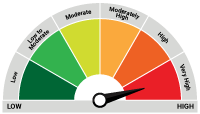Equity Year End Wrap-up & Outlook - 2023
Posted On Thursday, Dec 22, 2022
2022 was an eventful year when the global economy witnessed the cons of easy money flow (Quantitative Easing). Inflation across the globe tested multi-decadal highs forcing the global central banks to an interest rate hiking spree. Consequently, the US Federal Reserve increased the benchmark rate to its highest level in 15 years. Amidst all these, India turned out to be an outlier when most of the global markets clocked negative returns. The relatively stable equity market in India was a result of a smart economic recovery from the pandemic shock and the growing dominance of retail investors.
What does a higher interest rate mean for equity markets?
Stock prices reflect the present value of future cash flows that companies are likely to accumulate over their life. The discount rate used to discount future cash flows is a function of prevailing interest rates. Generally, companies trading at high valuations are more sensitive to an interest rate increase as the majority of the value emerges from high expectations on future cash flows. When interest rates increase, the high-valuation cohort tends to undergo a reset in valuation multiples to reflect the new reality. If we were to sort Nifty 50 stocks in terms of descending order of valuation multiples (P/E ratio is considered), the average annual returns of the top 15 ranked companies have exceeded the bottom 15 ranks by a wide margin from CY16 till CY21. As interest rates rose rapidly over the past year, the tide turned in favor of the bottom ranks - typically representative of the value style coming back in favor.
Source: Bloomberg; Current Nifty 50 stocks are considered; Data as of Dec 15, 2022
| Trailing 12 Months EPS Growth | Nifty (India) | MSCI EM (Emerging Market) | S & P 500 (US) |
| CY20 | -12.3% | -17.3% | -20.1% |
| CY21 | 77.6% | 56.3% | 56.1% |
| CY22 | 6.6% | -1.7% | 7.1% |
PE Ratio (Current) | 23.1 | 10.7 | 18.8 |
PE Ratio (10y Average) | 22.3 | 14.2 | 20.4 |
Source: Bloomberg, Data as of Dec 15, 2022.
Past performance may or may not be sustained in the future.
Over the past one-year, Indian markets were resilient and delivered positive returns compared to a double-digit decline in several of the global markets. As indicated in the above table, India’s outperformance was supported by robust earnings despite the Covid shock.
Another factor that supported the markets was strong flows from domestic retail investors. If we take the cumulative flows into equity markets since 2003, the share of flows since 2017 for FPI (Foreign Portfolio Investors) and Domestic Mutual Fund investors stands at 15% and 78% respectively (Data as of Nov 30, 2022). Unlike the experienced FPI, most retail investors haven’t seen a full market cycle yet. It will be interesting to see how retail investor behavior pans out over the long term. Nevertheless, Indian households' under-investment in equities (4.8% of Household Assets as of March 2022) grants ample scope for incremental flows. Historically, India has always traded at a premium to global markets due to the demographic dividend and reasonably stable policy environment. As the Indian market valuation is hovering close to its long-term average, the stock price returns henceforth will be largely driven by earnings growth. After many years of subdued earnings growth, the current earnings cycle in India looks promising in the medium term.
Stable Economic indicators
Domestic economic indicators continue to be reasonable. Credit demand and GST collections continue to remain healthy for many quarters in a row. Capacity utilization of the manufacturing sector surpassing the 70% mark indicates a possibility of private Capex revival. The government Capex trend is likely to be strong given the robust growth in tax collections. The possibility of good rabi crops and elevated crop prices are expected to revive rural demand. Even in case of a global slowdown, the impact on India is likely to be minimal given India’s strong domestic linkage (~70% of GDP from Domestic & Government Consumption).
Key Risks
Geopolitical tensions and China’s ease in Covid policy could trigger a rally in commodity prices including crude oil. Equity flows from FPIs could come under pressure given their possible preference for overseas markets posts the recent correction in their valuations. Persistent volatility in the domestic equity market could also lead to pressure on domestic MF flows.
What should an investor do?
Equity as an asset class stands out given its ability to beat inflation over the long term. Investors who remain invested for three years plus have had reasonable experience despite short-term volatility. Data shows that as the investment horizon increases, the chances of a negative return decrease considerably.
Rolling Returns based on Nifty TRI (Total Returns including Dividend) from 2000 till Nov 30, 2022:
| 1Y | 3Y | 5Y | 7Y | 10Y | |
| Minimum | -55% | -15% | -1% | 5% | 5% |
| Maximum | 109% | 62% | 47% | 30% | 22% |
| Average | 16.8% | 15.6% | 15.7% | 14.9% | 14.2% |
Source: Bloomberg
Past performance may or may not be sustained in the future.
We remain positive on Indian equities with a long-term perspective given its macro strength, reasonable valuations, and the potential persistence of earnings upcycle.
| Name of the Scheme | This product is suitable for investors who are seeking* | Risk-o-meter of Scheme | Riskometer of Tier I Benchmark | Riskometer of Tier II Benchmark |
Quantum Long Term Equity Value Fund (An Open Ended Equity Scheme following a Value Investment Strategy) | • Long term capital appreciation |  Investors understand that their principal will be at Very High Risk |  |  |
*Investors should consult their financial advisers if in doubt about whether the product is suitable for them.
Disclaimer, Statutory Details & Risk Factors:The views expressed here in this article / video are for general information and reading purpose only and do not constitute any guidelines and recommendations on any course of action to be followed by the reader. Quantum AMC / Quantum Mutual Fund is not guaranteeing / offering / communicating any indicative yield on investments made in the scheme(s). The views are not meant to serve as a professional guide / investment advice / intended to be an offer or solicitation for the purchase or sale of any financial product or instrument or mutual fund units for the reader. The article has been prepared on the basis of publicly available information, internally developed data and other sources believed to be reliable. Whilst no action has been solicited based upon the information provided herein, due care has been taken to ensure that the facts are accurate and views given are fair and reasonable as on date. Readers of this article should rely on information/data arising out of their own investigations and advised to seek independent professional advice and arrive at an informed decision before making any investments. Mutual fund investments are subject to market risks read all scheme related documents carefully.Please visit – www.quantumamc.com/disclaimer to read scheme specific risk factors. Investors in the Scheme(s) are not being offered a guaranteed or assured rate of return and there can be no assurance that the schemes objective will be achieved and the NAV of the scheme(s) may go up and down depending upon the factors and forces affecting securities market. Investment in mutual fund units involves investment risk such as trading volumes, settlement risk, liquidity risk, default risk including possible loss of capital. Past performance of the sponsor / AMC / Mutual Fund does not indicate the future performance of the Scheme(s). Statutory Details: Quantum Mutual Fund (the Fund) has been constituted as a Trust under the Indian Trusts Act, 1882. Sponsor: Quantum Advisors Private Limited. (liability of Sponsor limited to Rs. 1,00,000/-) Trustee: Quantum Trustee Company Private Limited. Investment Manager: Quantum Asset Management Company Private Limited. The Sponsor, Trustee and Investment Manager are incorporated under the Companies Act, 1956. |
Related Posts
-

Equity Monthly for January 2026
Posted On Friday, Jan 02, 2026
Indian markets remained range-bound in 2025
Read More -

Equity Monthly for December 2025
Posted On Wednesday, Dec 03, 2025
Markets continued the rising trend in October with Sensex gaining 2.2%.
Read More -

Equity Monthly for November 2025
Posted On Tuesday, Nov 04, 2025
Markets continued the rising trend in October with Sensex gaining 4.7%.
Read More



